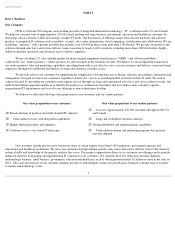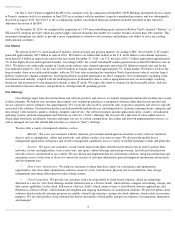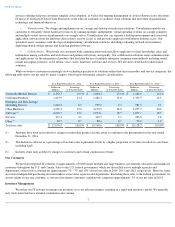CDW 2014 Annual Report Download - page 17
Download and view the complete annual report
Please find page 17 of the 2014 CDW annual report below. You can navigate through the pages in the report by either clicking on the pages listed below, or by using the keyword search tool below to find specific information within the annual report.
Table of Contents
created more rapid obsolescence or if our vendor partners were to change their terms and conditions, our inventory risks could increase. We also
from time to time take advantage of cost savings associated with certain opportunistic bulk inventory purchases offered by our vendor partners or
we may decide to carry high inventory levels of certain products that have limited or no return privileges due to customer demand or request.
These bulk purchases could increase our exposure to inventory obsolescence.
We could be exposed to additional risks if we continue to make strategic investments or acquisitions or enter into alliances.
We may continue to pursue transactions, including strategic investments, acquisitions or alliances, in an effort to extend or complement
our existing business. These types of transactions involve numerous business risks, including finding suitable transaction partners and
negotiating terms that are acceptable to us, the diversion of management's attention from other business concerns, extending our product or
service offerings into areas in which we have limited experience, entering into new geographic markets, the potential loss of key coworkers or
business relationships and successfully integrating acquired businesses, any of which could adversely affect our operations.
In addition, our financial results could be adversely affected by financial adjustments required by accounting principles generally
accepted in the United States of America (“GAAP”) in connection with these types of transactions where significant goodwill or intangible
assets are recorded. To the extent the value of goodwill or identifiable intangible assets with indefinite lives becomes impaired, we may be
required to incur material charges relating to the impairment of those assets.
Our future operating results may fluctuate significantly.
We may experience significant variations in our future quarterly results of operations. These fluctuations may cause the market price of
our common stock to be volatile and may result from many factors, including the condition of the technology industry in general, shifts in
demand and pricing for hardware, software and services and the introduction of new products or upgrades.
Our operating results are also highly dependent on our level of gross profit as a percentage of net sales. Our gross profit percentage
fluctuates due to numerous factors, some of which may be outside of our control, including general macroeconomic conditions; pricing
pressures; changes in product costs from our vendor partners; the availability of price protection, purchase discounts and incentive programs
from our vendor partners; changes in product, order size and customer mix; the risk of some items in our inventory becoming obsolete; increases
in delivery costs that we cannot pass on to customers; and general market and competitive conditions.
In addition, our cost structure is based, in part, on anticipated sales and gross margins. Therefore, we may not be able to adjust our cost
structure quickly enough to compensate for any unexpected sales or gross margin shortfall, and any such inability could have an adverse effect
on our business, results of operations or cash flows.
We are exposed to risks from legal proceedings and audits.
We are party to various legal proceedings that arise in the ordinary course of our business, which include commercial, employment, tort
and other litigation.
We are subject to intellectual property infringement claims against us in the ordinary course of our business, either because of the
products and services we sell or the business systems and processes we use to sell such products and services, in the form of cease-and-desist
letters, licensing inquiries, lawsuits and other communications and demands. In our industry, such intellectual property claims have become
more frequent as the complexity of technological products and the intensity of competition in our industry have increased. Increasingly, many of
these assertions are brought by non-practicing entities whose principal business model is to secure patent licensing revenue, but we may also be
subject to suits from inventors, competitors or other patent holders who may seek licensing revenue, lost profits and/or an injunction preventing
us from engaging in certain activities, including selling certain products and services.
Because of our significant sales to governmental entities, we also are subject to audits by federal, state and local authorities. We also are
subject to audits by various vendor partners and large customers, including government agencies, relating to purchases and sales under various
contracts. In addition, we are subject to indemnification claims under various contracts.
Current and future litigation, infringement claims, governmental proceedings, audits or indemnification claims that we face may result
in substantial costs and expenses and significantly divert the attention of our management regardless of the outcome. In addition, current and
future litigation, infringement claims, governmental proceedings, audits or indemnification claims could lead to increased costs or interruptions
of our normal business operations. Litigation, infringement claims, governmental proceedings, audits or indemnification claims involve
uncertainties and the eventual outcome of any litigation,
14
























